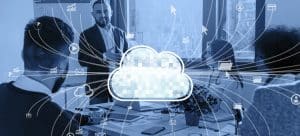As businesses are increasingly opting for digital transformation, they also need improved business management, fast processes, flexibility, and good returns. Cloud computing technologies provide the essential process enhancing options and scalability, ensuring the best results.
In simple words, cloud computing refers to the delivery of adding up services over the Internet. It includes storage, software, servers, databases, network, analytics, and intelligence. This pack of services aims for a fast outcome, adaptable resources, and economizing of scale.
Cloud computing has become the center of any business process. Organizations are looking for outsourced IT help desk Services to avail of more cloud services at a lower price. It allows universal and easy on-demand access to shared resources through flexible cloud services.
Cloud technology had a $543 billion market in 2021. Experts estimate that it will become an $864 billion market by 2025. Further, the market will see a compounded growth rate of 12.8% annually.
Cloud technologies include artificial intelligence, machine learning, edge computing, virtual desktops, automation, SASE, and disaster recovery. All these advanced services will shape the tomorrow of cloud computing. Let’s learn how these services can benefit your business.
10 Trends and Predictions of Cloud Computing
1. Edge Computing
With the increased reliance on cloud-based services, businesses are becoming more vulnerable to unknown networks through the internet. This situation has opened a new technology prospect called edge computing. It works by processing the data in the local system, avoiding the risks related to the cloud.
Further, edge computing technology helps decrease downtime, while improving safety and resilience. It is also more cost-effective than formal cloud services. Hence, edge computing can play a significant role in helping businesses to overcome the difficulties posed by cloud computing.
2. Internet of Things
The future of cloud computing has a close connection with the Internet of Things. With the increased digitalization, more and more devices share internet connections. It creates the need for secure and scalable cloud services to ensure your business growth.
Further, the IoT involves a wide range of data that needs to be stored and processed. The cloud platform provides the best possible data storage and processing options. You can decide outsourced IT help desk pricing based on this crucial cloud service of IOT.
3. More Data Storage Capabilities
In the era of virtual work, Data storage requirements continue to rise at a remarkable pace. So, businesses need easier and cheaper options to store their data in the cloud. Advanced cloud computing technology provides enhanced data storage capability that helps businesses store and process more data at a lower price.
Moreover, the usage of cloud-based tools and services is continuously rising as more and more organizations acknowledge the advantages of utilizing these applications. This trend will consequently boost the market for cloud computing in the coming years.
4. Artificial Intelligence
With the fast improvements in artificial intelligence (AI), more organizations are opting for the cloud to store and organize their data. One of the primary motivations behind this trend is AI-powered data analytics. It can assist in identifying designs and tendencies that you cannot detect without this particular technology.
Moreover, cloud-based AI techniques can improve and develop into more effective data processors. Consequently, the need for cloud-based AI services will continuously grow in the future.
5. Data Privacy and Cloud Mitigation
More and more businesses are opting for cloud-based services to store and process their data. This trend develops concerns about the privacy and safety of confidential data. So one of the critical challenges before cloud computing is to protect the data from illicit access and mishandling. The second biggest challenge is reducing the effect of disorders in cloud services, such as failure or natural catastrophes.
6. Disaster Recovery
Cloud computing delivers several advantages, such as enhanced flexibility, dependability, and scalability. Nonetheless, disaster recuperation is one of the most crucial advantages offered by cloud computing. In the event of an innate catastrophe or power fall, companies can still access their data and persist the operation without interruption. It means cloud computing is necessary for any organization that desires to confirm service continuity in the occasion of a disaster. Further, disaster recovery technology is the prior need of disaster recovery technology to ensure the least downtime in the client’s network.
7. Serverless Computing
Serverless computing is a recent addition to cloud computing. It has the ability to empower the process of hosting applications and services. The serverless computing model doesn’t include any physical servers that you need to maintain. The process instead works on application code implemented in response to events. The infrastructure needed to operate the code is supervised by the cloud provider.
It streamlines the deployment process and decreases the all-around expense of operating the application. Serverless computing is cost-effective as you only spend on the resources you practically utilize when your code is implemented. However, this technology is in its early stages, but it indicates to be reliable as a flexible and cost-effective manner to operate cloud-based applications. So, it will also ensure low IT help desk pricing as you will opt for services for a specific time.
8. Service Mesh
Service mesh is a new technology addition to cloud computing that aims to make the platform more efficient and flexible. In the service mesh, each service is separated from the other, which makes the system effortless to operate and monitor.
In Service Mesh, you can determine and resolve issues easily, as well as scale up or down the services as required. Moreover, service mesh comes with an in-built load balancing and auto-scaling method, which can further enhance capacity and flexibility.
9. Improved SASE Adoption
As network security is the most prioritized matter for businesses, an improved SASE adoption is sure to brighten the future of cloud computing. SASE refers to Software-Defined Networking which provides several benefits over formal networking standards.
SASE is much easier to operate and configure as all the network elements exist within one platform. Besides, it is more scalable and adjustable than formal networking systems making it suitable for the constantly changing platform of cloud computing.
10. Cloud Orchestration and Optimization
Cloud orchestration refers to the technique of automating and organizing the deployment, structure, incorporation, and supervision of cloud computing resources. Similarly, cloud optimization is the method of maximizing the efficient usage of resources. So jointly, these two strategies make an organization’s cloud infrastructure able to fulfill its ever-changing requirements in a cost-efficient way.
Conclusion:
Cloud computing makes your business process more efficient by adding up required services over the Internet. It includes storage, software, servers, databases, network, analytics, and intelligence. These services aim for a fast outcome, adaptable resources, and flexibility in services. It also simplifies the IT help desk outsourcing process by automating the procedures. For more information you can read Cloud computing trends 2023: Top predictions, stats, and growth drivers.







